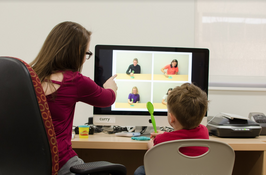LearnCenter for Developmental Science
Our Research
How do we learn linguistic patterns?

How do we integrate linguistic knowledge?

How do children and adults learn differently?

Our Methods

The way we attempt to answer these questions depends on the age of the child. For our infant studies, a child typically sits in their guardian's lap and is presented with displays of objects or videos as they listen to short sentences (this occurs in the "Infant Testing Room" seen in our lab video tour). We measure the infant's spontaneous reactions, such as how long they spend looking at each display. Older children might play interactive games that involve learning names for novel items, categorizing objects, interacting with a touchscreen, or choosing between toys. These studies are conducted in the "Child and Adult Testing Room". Below you will find some of our recent findings using these methods, and if you are interested in participating in one of our studies, let us know! You can also find us conducting research and sharing developmental science with the public at our Living Lab at the Children's Museum of Southern Minnesota.
Our Lab in the News...
Gustavus Students Explore How Children Learn at Children's Museum: The Center for Developmental Science has been conducting research at the Children's Museum of Southern Minnesota through a breakthrough program, the National Living Lab Initiative. The Center's student researchers have been conducting research in a live setting, setting a new precedent for the process of collecting data. Read more here.
Grant to Allow Psychology Students to Work in Living Lab: The Center for Developmental Science (CDS) at Gustavus Adolphus College and the Children’s Museum of Southern Minnesota (CMSM) in Mankato have been awarded a $3,000 stipend from the National Living Laboratory Initiative in Boston that will create unique opportunities for Gustavus psychology students. Read more here.
Play On Words: The Center for Developmental Science was written up in the Gustavus Annual Report 2012-2013!
Selected Publications & Presentations
White, K.S., Chambers, K.E., Miller, Z., & Jethava, V. (2016). Listeners learn phonotactic patterns conditioned on suprasegmental cues. The Quarterly Journal of Experimental Psychology. [PDF]
Chambers, K. E., Onishi, K. H., & Fisher, C. (2011). Representations for phonotactic learning in infancy. Language Learning and Development, 7, 287-308. [PDF]
Chambers, K. E., Olson, P., & Rao, A. (2011, April). Learning developmental psychology through museum exhibit design. Poster presented to the Developmental Science Teaching Institute at the Biennial Meeting of the Society for Research in Child Development, Montreal, QC, CAN. [PDF]
Chambers, K. E., Onishi, K. H., & Fisher, C. (2010). A vowel is a vowel: Generalizing newly-learned phonotactic constraints to new contexts. Journal of Experimental Psychology: Learning, Memory and Cognition, 36, 821-828. [PDF]
Khu, M., Nitka, D., Chambers, K. E., & Onishi, K. H. (2009, April). The effect of phonotactic regularities on infant word learning. Poster presented to the Biennial Meeting of the Society for Research in Child Development, Denver, CO. [PDF]
Fisher, C., Church, B., & Chambers, K. E. (2004). Learning to identify spoken words. In D. G. Hall and S. R. Waxman (Eds.), Weaving a Lexicon (pp. 3-40). Cambridge, MA: MIT Press. [PDF]
Chambers, K.E., Onishi, K.H., & Fisher, C. (2003). Infants learn phonotactic regularities from brief auditory experience. Cognition, 87, B69-B77. [PDF]
Onishi, K. H., Chambers, K. E., & Fisher, C. (2002). Learning phonotactic constraints from brief auditory exposure. Cognition, 83, B13-B23. [PDF]
Fisher, C., Hunt, C. M., Chambers, K. E., & Church, B. A. (2001). Abstraction and specificity in preschoolers' representations of novel spoken words. Journal of Memory and Language, 45, 665-687. [PDF]